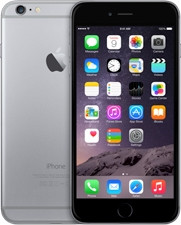
In our recent review of the iPhone 6, we concluded demanding business users should also consider the bigger iPhone 6 Plus. Does the huge screen make this the ultimate iPhone for all business users? ITWeb thoroughly tested and reviewed Apple's biggest iPhone yet to seek the answer.
For the last couple of weeks, we've walked around with the massive iPhone 6 Plus in our pockets and mainly used it for typical business and office activities. We wanted to know if Apple has succeeded in creating a big smartphone ideal for use at the office as well as on the road.
Similarities and differences
The iPhone 6 and 6 Plus share a lot of similar hardware and features. There are, however, some important technical differences between the two:
iPhone 6 | iPhone 6 Plus | |
Weight | 129g | 172g |
Dimensions | 138 x 67 x 6.9mm | 158 x 78 x 7.1mm |
Screen | 4.7-inch | 5.5-inch |
Resolution | 1 334 x 750 (326ppi) | 1 920 x 1 080 (401ppi) |
Contrast ratio | 1 400:1 | 1 300:1 |
Battery | 1 810mAh | 2 915mAh |
Camera | Digital image stabilisation | Optical image stabilisation |
The iPhone 6 Plus features the same ergonomic, curved design we saw earlier on the iPhone 6. It ensures a pleasant and comfortable feel in the hand, but also enforces a firmer grip when holding or picking up the phone. Another unfortunate similarity is the protruding camera lens that makes the iPhone 6 Plus slightly wobbly when on its back, and the camera possibly prone to scratches. We didn't like this design flaw on the iPhone 6 and still don't like it on the bigger 6 Plus. Furthermore, its on-board NF chip is equally useless because the Apple Pay service it was designed for isn't active in SA.
As with the iPhone 6, we also wanted to see for ourselves how bendable the iPhone 6 Plus actually is. In reality, we found the iPhone 6 Plus to be quite solid and firm and should easily survive the roughest and toughest days at the office.
Size: two hands required
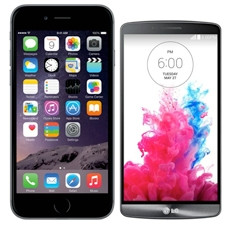
Larger smartphones require a somewhat different design approach than smaller models. The chassis and bezels (space around the screen) should ideally be as compact as possible to support better usability. Also, the correct use of grip-enhancing materials becomes more important when size increases. Clearly, these two points of attention weren't on the top priority list at Apple HQ when they designed the iPhone 6 Plus - as a result, it feels and looks unnecessarily big and clumsy. When compared to the LG G3, another 5.5-inch phone, it's hard to believe both screens are actually the same size.
As a consequence of the bulky bezels at the top and bottom, holding the iPhone 6 Plus with just one hand has proven quite a challenge. Since it also has a very smooth back side, and features a curved design, we often had the idea the device was about to fall out of our hands. Also, when holding it in one hand, the Touch ID-Home button is almost unreachable. These usability issues all lead to one simple conclusion and solution: the iPhone 6 Plus is a two-hands phone.
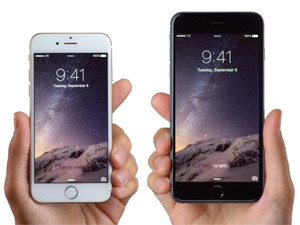
And if, for some reason, you really only have one hand available, there is always the built-in "Reachability" option. By gently touching the Touch ID-Home button twice, content at the top of the screen scrolls down, hopefully to within reach of your thumb. This is, however, a typical catch-22 situation since it's the same Touch ID-Home button that is so difficult to reach. When you do try your luck, the iPhone 6 Plus tends to become top-heavy and could easily slip out of your hand. Issues like these only confirm our suspicion that Apple didn't think the design of the 6 Plus through as much as they did with the smaller iPhone 6.
Screen: is bigger better for business?
The most noticeable and important difference between the two iPhone 6 models is the size of the screen. The 6 Plus features a 5.5-inch display with full-HD resolution and a pixel density of 401ppi. Both the resolution and pixel density only become visible when putting the iPhone 6 and 6 Plus side by side and examining the screens at close range.
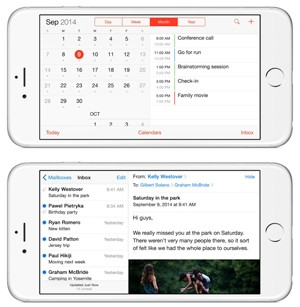
The bigger screen of the iPhone 6 Plus has two explicit advantages for business users. It can display more information without having to scroll, and typing is made easier because of the larger on-screen keyboard.
These advantages become even more evident when holding the iPhone 6 Plus horizontally (landscape mode). Typical business apps like Mail, Calendar and Messages dynamically adjust their presentation to the horizontal mode and try to make optimal use of the big screen and high resolution by dividing it into two separate columns. This feature is only available on the iPhone 6 Plus and has proven very productive and useful. It makes navigating through e-mails and appointments extremely easy and fast.
We hope more third-party apps will follow this two-column concept in their next app update. Unfortunately, iOS 8 lacks a handy split-screen mode that allows two different apps to be displayed side by side, like some Android devices are able to.
Pre-installed apps like Pages, Numbers and Keynote also benefit from the bigger screen and higher resolution, mainly in horizontal mode. These apps can now display even more characters and cells than on previous iPhones. Third-party apps do need to be specifically updated and optimised to make use of the additional iPhone 6 Plus screen and resolution. As with all previous newly introduced iPhones, that's just a matter of time.
In horizontal mode, the on-screen keyboard also adapts its form and functionality to make even better use of the additional screen real estate. Extra keys that don't show in vertical mode, like copy and paste, are now added to the on-screen keyboard. The bigger screen also makes typing even easier, and less sensitive to errors, compared to the iPhone 6 and, even more so, older models.
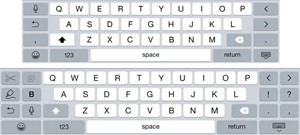
Business users will definitely enjoy the new horizontal on-screen keyboard, its enhanced usability and new array of options, as long as they are willing to use both hands. As a result, the iPhone 6 in horizontal mode might even be a serious alternative for those who find the iPad (Mini) a bit too bulky to carry around all the time at the office or on the road.
Unfortunately, as a result of the top and bottom bezels being so big, typing in horizontal mode is not as comfortable as it could have been. Even if you have big hands, it takes quite some effort to reach those middle keys in horizontal mode. Luckily, with iOS 8 it is possible to choose different sorts of input methods and keyboards, like Swiftkey and Swype. They offer new and unique options and features that might possibly mitigate this discomfort.
Performance: almost identical
The iPhone 6 Plus uses the same A8 processor that we found in the iPhone 6. Unfortunately, it's not equally fast because of the higher number of pixels it has to address. The good news is this decrease in performance only revealed itself during the graphics-intense GFXBench test we ran. For typical day-to-day business-related tasks, both iPhone 6 models perform identically well and easily outperform high-end Android phones.
Battery life: Impressive
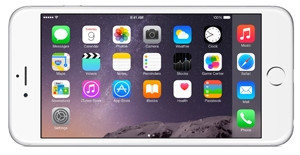
Battery life is a key consideration for business users. Longer battery life means less dependency on a power source or charger. Because of its bigger chassis, the iPhone 6 Plus also facilitates a bigger battery than the iPhone 6. It's got a bigger screen so it needs more energy. But Apple didn't stop there. When designing the iPhone 6 Plus, it made sure it would considerably outlast previous iPhone models and most high-end Android devices. This makes the iPhone 6 Plus ideal for mobile business users who travel a lot.
In our battery test that simulates heavy business usage, the smaller iPhone 6 was completely drained after 7.5 hours. The iPhone 6 Plus lasted for 8.5 hours. In real-life, this roughly translates into two more hours of typical business use (mail, browsing, calendar, messaging, calling etc) for iPhone 6 Plus owners. Compared to high-end Android phones, only the HTC One (M8) outlasted the iPhone 6 Plus by 30 minutes. It would be safe to state that the iPhone 6 Plus can easily endure the longest of working days at the office, even those including serious overtime.
Camera: Not afraid of the dark
The iPhone 6 and 6 Plus are equipped with very similar cameras. There's just one major difference in the way they try to reduce the impact of shaky hands. The iPhone 6 Plus uses optical image stabilisation where actual moving mechanics inside the camera intercept and neutralise tiny vibrations. In the iPhone 6, on the other hand, software technology tries to do the trick as best as possible.
In our semi-dark test scenario, the iPhone 6 Plus automatically chose a lower ISO value resulting in less image noise. Especially in low-light situations, the iPhone 6 Plus produces even better pictures than the iPhone 6, which is already quite good. To bring things into perspective, the picture quality of the iPhone 6 Plus surpassed those of competitive Android smartphones like the LG G3, HTC One (M8) and Galaxy S5. The additional optical stabilisation makes the camera on the iPhone 6 Plus ideal for business trips or important corporate events, especially those taking place in low-light conditions. As far as we could tell, the superior optical image stabilisation only works on photos, not video.
Verdict
The iPhone 6 Plus isn't the ideal phone for all business users. Only those who don't mind using it with two hands, and have serious cash to spare, will benefit from the bigger screen, great battery life and superior camera.
Business users who have only one hand to spare, and intend to keep it that way, should stay away from the iPhone 6 Plus. For them, the smaller iPhone 6 is a much better option.
Share